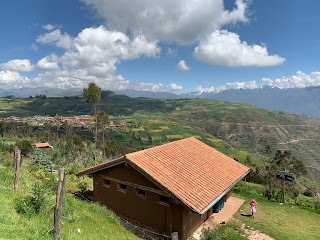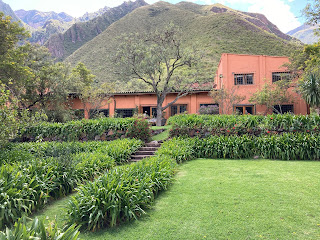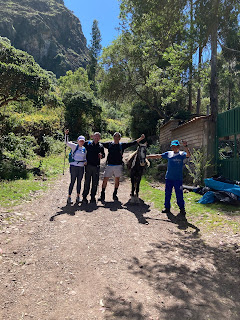The Sacred Valley
Like I mentioned in the last post, everything you do leading up to the trek is preparing you for the trek. On our second full day in the Cusco region we headed out for a tour of the Sacred Valley. The Sacred Valley runs from east to west and includes everything on the Urubamba River, a river that runs through the Andes, almost parting the mountains to run through them.
The first thing I’ll say is that BK and I were surprised at how much this area reminded us of the Valais in Switzerland. Of course, that’s a river that cuts through the Alps, with mountains jutting up all around it and towns dotting the mountainside. I’ve told a number of people lately that if we have to choose, we will always head to the mountains (not the beach). Since returning from Switzerland it’s been Colorado (Winter Park x2, Colorado Springs), Canada, Lake Tahoe, Yellowstone…the list goes on. To be fair, we’ve been to the beach, but it’s generally not our idea.
We had a weaving demonstration and learned how they naturally dye fabric to create all kinds of things- scarves, capes, blankets, gloves, hats, sweaters- you name it and they can probably knit it. It was good to buy directly from the person who created the item. We also learned about the difference between baby alpaca, regular alpaca and llama. Clearly, we have lots of people who helped make our trip possible (childcare) so we had plenty of things to buy and bring back. Also, the locals really enjoyed dressing BK and me up- more on that later.
At each stop our guide would check in to see how we were feeling. The next stop was Ollantaytambo, which was our first real test. Ollantaymbo is an archaeological site with A LOT of stairs. It is another Inka site that is pretty well developed, including a lot of farming terraces along with other temples and buildings in the site. The site also has a lot of pink granite, which I really liked, as it looks purple. We climbed all the stairs and hiked around to see what the site held. When you visit these sites if you look around at any of the surrounding mountains they always also have lookouts and buildings that supported whatever site you’re visiting. Fascinating.
We then drove to La Hacienda Huayoccari for lunch, which was at an amazing restaurant that had been a family home for years and only in the past 10 years or so been turned into a restaurant. Unfortunately the drive up to the home was lots of off road turns, so I was not feeling my best when I arrived. I felt bad because I did not want them to think I did not appreciate the beauty of their place or how great their food was. But wow, sometimes those mountain roads just get to you. They have a pretty extensive family collection of Inka artifacts as well. Highly recommend if you have the chance to go!
After lunch we headed toward Pisac to explore our final destination of the day. Pisac is one of the larger towns in the Sacred Valley, with extensive ruins outside of the city. There are many, many levels of farming terraces, guard shacks, storage buildings and a pretty developed settlement overall. On the way home we visited the city, which typically would have been bustling but unfortunately was very dead. There wasn’t much to do or see, so we didn’t hang around long.
We then went back to the hotel in Cusco to do our final preparations for the trek. Bright and early the next morning!










Comments
Post a Comment